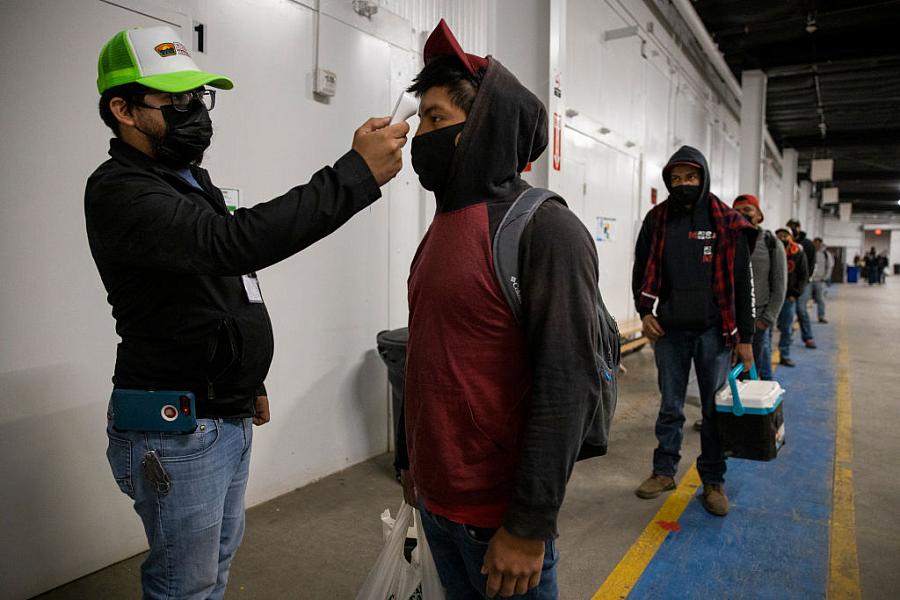‘COVID was the disease that revealed our illness as a society,’ equity researcher says

Migrant farm laborers have their temperature checked before boarding a bus to their shift in King City, California in April 2020.
(Photo by Brent Stirton/Getty Images)
Even before COVID-19 spread across the globe in early 2020, Manuel Pastor predicted that the economic, racial, and societal inequities already in place would be exacerbated in a pandemic, causing far more harm to Los Angeles County’s most vulnerable residents.
The signs were all present, said Pastor, a professor and the director of the Equity Research Institute at USC, reflecting on the past year.
Pastor said data comparing earnings show how the wage gap has widened between the working poor and rich across California. High rents have forced lower income and immigrant families to live in smaller, tighter apartments in dense neighborhoods. Many students still lacked computers and high-speed internet to do homework. Workers in some of the riskiest jobs continued to earn low pay because of their citizenship status, which also disqualified them for federal aid.
All those barriers were already in place when the pandemic hit, which is why it would be a mistake to go “back to the way we were before COVID-19,” said Pastor. (He co-authored a widely cited report released last fall titled “No Going Back: Together for an Equitable and Inclusive Los Angeles.”)
“COVID was the disease that revealed our illness as a society,” Pastor told journalists attending the 2021 California Fellowship via Zoom this week, referring to his report.
Initially, the goal of the report, a collaboration between USC and UCLA and funded by several nonprofit organizations, was to outline strategies for systemic change in Los Angeles after COVID-19. But what also surfaced in their research was how much the inequities in place had already stunted economic growth, even before the pandemic, Pastor said.
From early on in the pandemic, he noted that the first people to test positive were those from affluent communities. They had likely contracted the highly contagious virus through travel and had access to testing. From there, COVID-19 swiftly infected low-wage earners in food service sectors such as markets, warehouses and farms. These workers are more likely to live in smaller spaces, with more people, he said.
“This was going to rip its way through immigrant communities,” Pastor said, recounting his repeated warnings from early last year. Data in his report show that high-risk jobs in Los Angeles County are predominantly held by workers who are Black, Asian American immigrants, and Latinos.
Recent findings released by the Los Angeles County Department of Public Health also noted the disparity, especially between men and women of color. The department found that of the more than 23,000 people who have died of COVID-19 in Los Angeles County, the mortality rate among men was nearly double the rate for women.
“Black/African American and Latino/Latinx males also experience higher rates of mortality than Asian and White males,” public health officials said in a news release. “The mortality rate for Black Los Angeles County male residents is 267 deaths per 100,000 people and for Latino males, the mortality rate is 490 deaths per 100,000 people; this is nearly two and a half times the mortality rate for Asian males and more than three times the mortality rate for White males.”
The disparity in cases and deaths among people of color has also been reflected in vaccination efforts.
“The vaccine rollout (showed the) difference between equality and equity,” Pastor said. While everyone in certain occupations were equally eligible for the vaccine, there were differences in their ability to get the shots, Pastor noted. Those differences included whether or not workers and seniors had computer access and high-speed internet, whether they were savvy enough to navigate complex, glitchy systems, and if they had time to do so, he added.
“Latinos don’t have jobs where they can dash off to an appointment,” he said. They are also more likely to depend on public transportation. Some harbor mistrust of vaccines, government programs, and the American medical profession in general.
Pastor said there is a need for more community clinics to offer vaccines, and said workplace vaccinations, such as those recently offered to farmworkers in the fields would be highly effective. Lastly, he suggested that schools also serve as vaccination sites, since for many Latinos, schools are the government institution they trust most.
Pator urged journalists to continue reporting on the wage gap and access to education.
“I’m optimistic that we can turn the page right now,” Pastor said, “as long as we can continue to shine the spotlight on what is wrong and what is right.”
**

